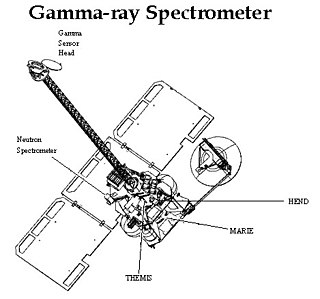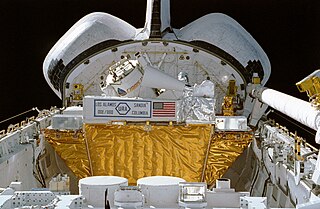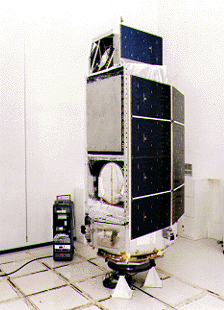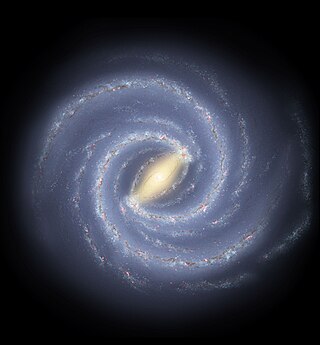
The Compton Gamma Ray Observatory (CGRO) was a space observatory detecting photons with energies from 20 keV to 30 GeV, in Earth orbit from 1991 to 2000. The observatory featured four main telescopes in one spacecraft, covering X-rays and gamma rays, including various specialized sub-instruments and detectors. Following 14 years of effort, the observatory was launched from Space Shuttle Atlantis during STS-37 on April 5, 1991, and operated until its deorbit on June 4, 2000. It was deployed in low Earth orbit at 450 km (280 mi) to avoid the Van Allen radiation belt. It was the heaviest astrophysical payload ever flown at that time at 16,300 kilograms (35,900 lb).

Lodewijk van den Berg was a Dutch-born American chemical engineer. He studied crystal growth and flew on a 1985 Space Shuttle Challenger mission as a payload specialist.
A semiconductor detector in ionizing radiation detection physics is a device that uses a semiconductor to measure the effect of incident charged particles or photons.

A gamma-ray spectrometer (GRS) is an instrument for measuring the distribution of the intensity of gamma radiation versus the energy of each photon. The study and analysis of gamma-ray spectra for scientific and technical use is called gamma spectroscopy, and gamma-ray spectrometers are the instruments which observe and collect such data. Because the energy of each photon of EM radiation is proportional to its frequency, gamma rays have sufficient energy that they are typically observed by counting individual photons.

The Gamma Ray Spectrometer (GRS) is a gamma-ray spectrometer on the 2001 Mars Odyssey spacecraft, a space probe orbiting the planet Mars since 2001. Part of NASA's Mars Surveyor 2001 program, it returns geological data about Mars's surface such as identifying elements and the location of water. It is maintained by the Lunar and Planetary Laboratory at the University of Arizona in the United States. This instrument has mapped the distribution surface hydrogen, thought to trace water in the surface layer of Martian soil.

Reuven Ramaty High Energy Solar Spectroscopic Imager was a NASA solar flare observatory. It was the sixth mission in the Small Explorer program (SMEX), selected in October 1997 and launched on 5 February 2002, at 20:58:12 UTC. Its primary mission was to explore the physics of particle acceleration and energy release in solar flares.

Neil Gehrels Swift Observatory, previously called the Swift Gamma-Ray Burst Explorer, is a NASA three-telescope space observatory for studying gamma-ray bursts (GRBs) and monitoring the afterglow in X-ray, and UV/Visible light at the location of a burst. It was launched on 20 November 2004, aboard a Delta II launch vehicle. Headed by principal investigator Neil Gehrels until his death in February 2017, the mission was developed in a joint partnership between Goddard Space Flight Center (GSFC) and an international consortium from the United States, United Kingdom, and Italy. The mission is operated by Pennsylvania State University as part of NASA's Medium Explorer program (MIDEX).

HEAO-1 was an X-ray telescope launched in 1977. HEAO-1 surveyed the sky in the X-ray portion of the electromagnetic spectrum, providing nearly constant monitoring of X-ray sources near the ecliptic poles and more detailed studies of a number of objects by observations lasting 3–6 hours. It was the first of NASA's three High Energy Astronomy Observatories, HEAO 1, launched August 12, 1977 aboard an Atlas rocket with a Centaur upper stage, operated until 9 January 1979. During that time, it scanned the X-ray sky almost three times

The INTErnational Gamma-Ray Astrophysics Laboratory (INTEGRAL) is a space telescope for observing gamma rays of energies up to 8 MeV. It was launched by the European Space Agency (ESA) into Earth orbit in 2002, and is designed to provide imaging and spectroscopy of cosmic sources. In the MeV energy range, it is the most sensitive gamma ray observatory in space. It is sensitive to higher energy photons than X-ray instruments such as NuSTAR, the Neil Gehrels Swift Observatory, XMM-Newton, and lower than other gamma-ray instruments such Fermi and HESS.

Suzaku was an X-ray astronomy satellite developed jointly by the Institute of Space and Aeronautical Science at JAXA and NASA's Goddard Space Flight Center to probe high energy X-ray sources, such as supernova explosions, black holes and galactic clusters. It was launched on 10 July 2005 aboard the M-V launch vehicle on the M-V-6 mission. After its successful launch, the satellite was renamed Suzaku after the mythical Vermilion bird of the South.

AFP-675 was a Space Shuttle experiment package that was carried into orbit on Discovery as part of STS-39.

Cornelis A. "Neil" Gehrels was an American astrophysicist specializing in the field of gamma-ray astronomy. He was Chief of the Astroparticle Physics Laboratory at NASA's Goddard Space Flight Center (GSFC) from 1995 until his death, and was best known for his work developing the field from early balloon instruments to today's space observatories such as the NASA Swift mission, for which he was the principal investigator. He was leading the WFIRST wide-field infrared telescope forward toward a launch in the mid-2020s. He was a member of the National Academy of Sciences and the American Academy of Arts and Sciences.

The last of NASA's three High Energy Astronomy Observatories, HEAO 3 was launched 20 September 1979 on an Atlas-Centaur launch vehicle, into a nearly circular, 43.6 degree inclination low Earth orbit with an initial perigeum of 486.4 km. The normal operating mode was a continuous celestial scan, spinning approximately once every 20 min about the spacecraft z-axis, which was nominally pointed at the Sun. Total mass of the observatory at launch was 2,660.0 kilograms (5,864.3 lb).
The High Energy Astronomy Observatory Program was a NASA program of the late 1970s and early 1980s that included a series of three large low-Earth-orbiting spacecraft for X-ray and Gamma-Ray astronomy and Cosmic-Ray investigations. After launch, they were denoted HEAO 1, HEAO 2, and HEAO 3, respectively. The large (~3000 kg) satellites were 3-axis stabilized to arc-minute accuracy, with fixed solar panels. All three observatories were launched from Cape Canaveral, Florida on Atlas-Centaur SLV-3D launch vehicles into near-circular orbits with initial altitudes slightly above 500 km.

Gamma-ray astronomy is the astronomical observation of gamma rays, the most energetic form of electromagnetic radiation, with photon energies above 100 keV. Radiation below 100 keV is classified as X-rays and is the subject of X-ray astronomy.

Bonnard John Teegarden is an American astrophysicist formerly with NASA's Goddard Space Flight Center, now retired. He spent most of his career studying cosmic gamma rays and is best known to the public for leading the team that discovered Teegarden's star in 2003.

The history of X-ray astronomy begins in the 1920s, with interest in short wave communications for the U.S. Navy. This was soon followed by extensive study of the earth's ionosphere. By 1927, interest in the detection of X-ray and ultraviolet (UV) radiation at high altitudes inspired researchers to launch Goddard's rockets into the upper atmosphere to support theoretical studies and data gathering. The first successful rocket flight equipped with instrumentation able to detect solar ultraviolet radiation occurred in 1946. X-ray solar studies began in 1949. By 1973 a solar instrument package orbited on Skylab providing significant solar data.
The Nuclear Compton Telescope (NCT) is a balloon-borne Compton telescope to observe the gamma-ray sky in the energy range from a few hundred keV to several MeV. Its main goals are to improve the understanding of Galactic nucleosynthesis, gamma-ray bursts, supernovae, black holes, and more.

Kenneth John Frost was a pioneer in the early space program, designing and flying instruments to detect and measure X-rays and gamma-rays in space, primarily from the Sun. He was the first to suggest the use of an active scintillation shield operated in electronic anticoincidence with the primary detector to reduce the background from cosmic ray interactions, an innovation that made sensitive hard X-ray and gamma-ray astronomy possible. He was an American astrophysicist at Goddard Space Flight Center working as a civil servant for the National Aeronautics and Space Administration. During his career, he was the project scientist of the Solar Maximum Mission, principal investigator of six science instruments, the head of the Solar Physics Branch, and the associate director of Space Sciences.

The Compton Spectrometer and Imager (COSI), is a gamma-ray telescope expected to launch in 2027 as a NASA small astrophysics mission. It is intended to study the recent history of star birth, star death, and the formation of chemical elements in the Milky Way.




















